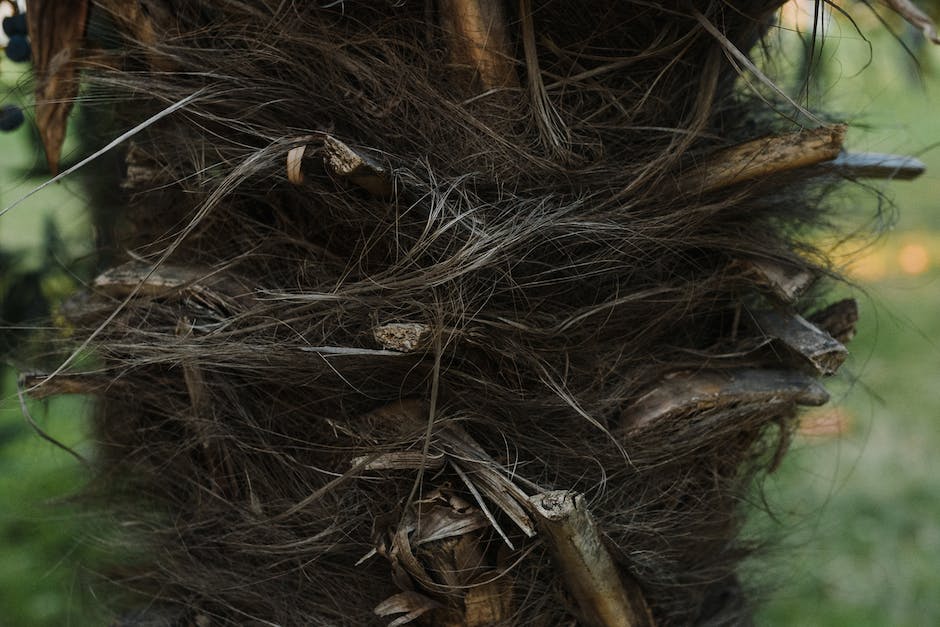One of the most popular palms in landscaping is the queen palm (Syagrus romanzoffiana). It is a fast-growing palm that can reach up to 50 feet in height. The queen palm has a smooth, gray trunk with leaflets that are 3 to 5 inches long. The tree produces small, yellow-orange fruits.
The queen palm is native to Brazil, but it has been introduced to many other countries and can be found in warm climates throughout the world. The queen palm is not actually a true palm, but is more closely related to the cocos palm.
The queen palm is a popular choice for landscaping because it is fast-growing and provides shade. The tree is also relatively easy to care for and is tolerant of most soil types. However, the queen palm does have some drawbacks. The tree can be messy, dropping leaves and fruits. The tree also has a shallow root system that can damage paving and other hardscapes.
If you are considering adding a queen palm to your landscape, you will need to know how to skin the trunk. The process is relatively simple, but it does require some care. Here is a step-by-step guide to skinning a queen palm tree trunk.
To skin a queen palm tree trunk, use a sharp knife to carefully remove the outer layer of the trunk. Be sure to avoid cutting into the inner bark as this can damage the tree. Once the outer layer is removed, the trunk can be sanded smooth and painted or stained as desired.
Should you skin a palm tree trunk?
Palm trees are a great addition to any home or landscape. They are easy to care for and don’t require a lot of maintenance. However, it is important to skin the tree once a year to keep it healthy. This simple task will ensure that your palm tree stays healthy and beautiful for years to come.
Queen palm trees can be trimmed in late September through early November for the best results. Cut dead fronds with a saw a couple of inches from the trunk. Check the base of the leaf stem before removing the frond. If the base of the leaf stem is green, it is not dead and should not be removed.
How do you skin palm trees
You want to cut as close to the stem as possible without damaging the plant. Use a sharp knife or pruning shears for this.
Cutting too deep into the tree trunk can and will leave scars to the palm tree, which in short will hurt the tree when it comes to the transfer of nutrients. Skinning a palm tree should be limited to only once a year.
When should you uncover a palm tree?
If you have a palm tree that you need to cover for more than three days, you should uncover it during the day to provide it with some light. For a larger palm, use a blanket, burlap or other warm material.
Skinning or shaving a palm tree involves removing the rough, shaggy bark and dead frond remnants from the trunk. This results in a smooth, attractive trunkline that naturally leads your eye up towards the green, waving fronds. Unshaved palms, on the other hand, often have an ugly, hairy appearance.
What is the best tool for trimming queen palms?
When it comes to queen palms, shears are the best tools to use. This is especially true if the palms are still at or just above head height. Long-handled shears have longer blades that are better suited for cutting thick stems. Additionally, the longer handle will allow you to reach into the crown of the tree without having to strain.
When you see a frond beginning to yellow or brown on your Queen Palm, it’s time to trim it off so a new frond can take its place. Not only does this keep your palm looking magnificent, but helps keep it healthy too.
How much does it cost to skin a palm tree
If you’re considering palm tree skinning, it’s important to know how much it might cost. Prices can vary depending on the size of the palm and the thickness of the trunk, but the average price is around $325. Keep in mind that this is just an average, so costs could be significantly lower or higher depending on your specific situation.
1) Pruning dead and dying lower fronds improves the appearance of a palm.
2) Dead and dying fronds and loose petioles are weakly attached to some palms and can place people and property at risk if they fall from tall palms.
Should you wrap palm trees?
If you are expecting a severe ice storm or the temperature is going to be below 25 degrees for a 24 hour period, you should wrap your palm. Keep a long sheet of frost cloth and a sturdy strap or rope handy for this purpose. These same supplies can be reused year after year. Start by tying the fronds together.
If your palm’s fronds have a diameter that’s smaller than one inch, you can use a serrated knife to trim them. If you need to remove flower stalks, you can also use this tool. If the fronds are slightly larger than this, use pruning shears or a large clipper.
What is the best month to trim palm trees
Palm trees are a type of tree that is common in tropical and subtropical climates. They are known for their beautiful palm fronds and their ability to provide shade and shelter from the sun and rain. When trimming a palm tree, it is important to take into account the time of year and the tree’s health. Trimming a palm tree in the summer, late spring, is ideal as the tree will be able to recover and thrive more easily than if it was trimmed in the mid-summer.
Palm trees have short lifespans in comparison to other trees. The areca palm has a lifespan of 40 to 50 years, while the coconut palm lives betwee 70 and 100 years. Date palms have a lifespan of 100 to 120 years. In some cases, date palms can reach 200 years of age.
Why do they trim palm tree trunks?
Pruning and trimming your palm trees is an important part of keeping them healthy and thriving. Removing old growth and dead waste will help encourage new growth, and ensure that your palm tree is able to reach its full potential.
Mulching small palms helps to protect the plant from the cold and also helps to retain moisture. A layer of chopped leaves should be used to cover the base and crown, but the plant should not be completely smothered. During a cold snap, the entire plant should be protected by adding a box or blanket over the leaf mulch. However, a palm should not be completely covered (excluding sunlight) for more than three days.
Why do you wrap palm trees for the winter
Tying up the leaves and insulating the Christmas palm sufficiently will prevent cold weather from penetrating into the heart of the palm. Wrapping the trunk with Christmas lights (non-LED) inside the insulation, but not in direct contact with the plant, will help to prevent the trunk from freezing. Insulating the ground with mulches is also a good idea.
One of the best ways to protect trees from frost damage is to completely cover them from top to bottom with burlap, old blankets or frost cloth. This will trap warm air in around the tree and help to prevent the tree from being damaged by frost. It is important that the cloth does not touch the tree, so drive stakes in the ground that are slightly taller than the tree and drape the cloth over the stakes.
Final Words
There are a few different ways that you can skin a queen palm tree trunk, but the most common method is to use a sharp knife or saw. First, you will need to remove all of the leaves from the trunk. Next, you will need to cut away any remaining bark or excess wood until you are left with a smooth surface. Finally, you will need to sand down the trunk to create a smooth,even surface.
The best way to remove the bark from a queen palm tree is to use a chisel and ahammer. First, make a series of cuts perpendicular to the grain of the wood,being careful not to damage the underlying tissue. Next, use the chisel to prythe bark off in strips. Finally, use the hammer to remove any remainingbark.
Mark Hoffman is a dedicated arborist and tree care specialist with over a decade of experience. His love for trees began when he visited Yosemite National Park as a teenager and was awestruck by the giant sequoias. Mark pursued his passion by studying forestry at Michigan Technological University, where he earned a Bachelor of Science degree.
Since then, he has worked tirelessly in the field of arboriculture, helping to preserve and protect trees in his community. His expertise and dedication have made him a respected leader in the industry and a valuable resource for anyone seeking advice on tree care.
